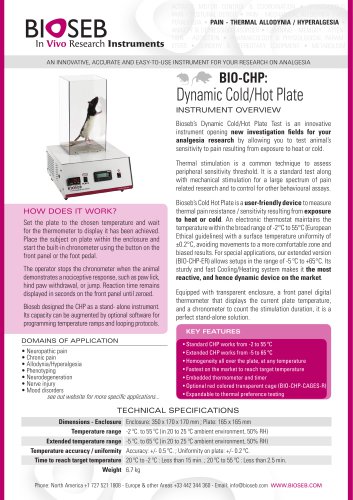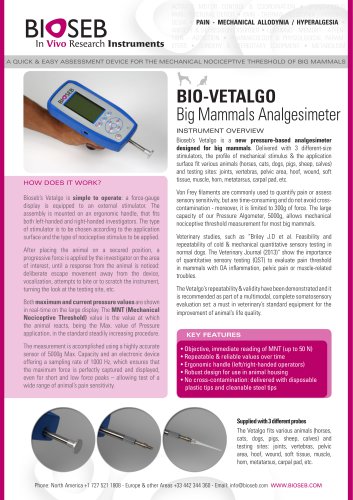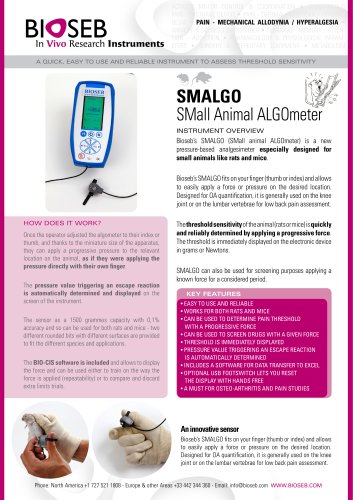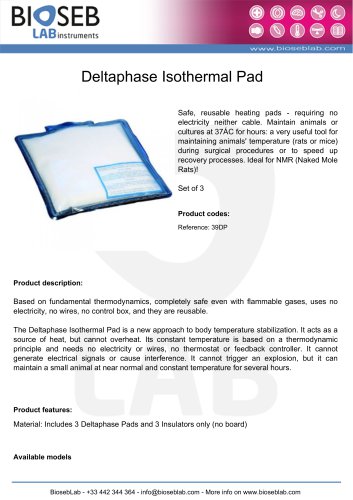 Website:
Bioseb
Website:
Bioseb
Catalog excerpts
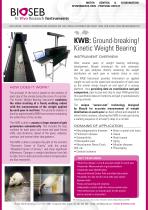
ACTIVITY, MOTOR CONTROL & COORDINATION • SPONTANEOUS PAIN - POSTURAL DEFICIT • PAIN - THERMAL ALLODYNIA / HYPERALGESIA • PAIN - MECHANICAL ALLODYNIA / HYPERALGESIA • ANXIETY & DEPRESSION DISORDER • LEARNING - MEMORY - ATTENTION - ADDICTION • PHARMACOLOGY & PHYSIOLOGICAL PARAMETERS • SURGERY & STEREOTAXY EQUIPMENT • METABOLISM EXCLUSIVE: YIELDS INFORMATION CURVES ON THE FORCE DISTRIBUTION OVER TIME FOR EACH PAW INDEPENDENTLY KWB: Ground-breaking! Kinetic Weight Bearing INSTRUMENT OVERVIEW After several years of weight bearing technology development, Bioseb introduced the only automatic test for gait analyses directly assessing the weight distribution on each paw in rodents (mice or rats). HOW DOES IT WORK? The principle of the test is based on the analyse of each step of the animal during the cross of a corridor. The Kinetic Weight Bearing instrument combines the video tracking of a freely walking rodent with the measurement of the weight applied by each paw in real time. This postural analysis is done by approximately 6000 force sensors composing the whole floor of the corridor. The KWB is able to assess a large amount of gait parameters automatically. This includes the step numbers for each paws with mean and peak Forces (mN), step durations, Speed of the paws, cadence, overlaps, and several other step patterns. The KWB is able to compare the path of the animal’s “Geometric Center of Gravity” with the actual “Weighted Center of Gravity”, and show significant differences. Changes in weight distribution from left to right, front to back and contra-lateral compensation are also measured. The KWB Instrument provides information on applied weight as well as the speed and acceleration of each paw as the animal moves toward an end point of a runway platform - thus providing data on coordination and gait comparison, paw to paw and step to step! KWB generates this quantitative data on footprints and gait in spontaneously moving animals. The unique “sensor-mat” technology designed by Bioseb for accurate measurement of weight distribution on each paw has been refined and adapted to allow kinetic analysis, allowing the KWB to track gait during a walking sequence of at least 5 steps in a corridor. DOMAINS OF APPLICATION • Neurodegenerative diseases • Parkinson’s disease • Osteoarthritis • Neuropathic pain • Neurotrauma: Nerve Crush, SNI, etc. • Cerebral ischemia • Brain or spinal cord injury • Ataxia • Brain trauma • Aging • Muscles diseases • Phenotyping KEY FEATURES • Real-time display: curve & average weight for each paw • Automatic Measurement of gait parameters • Automatic paw identification • Records Gravity Center Path and video barycenter • Available for rats and for mice with easy switch between both • Easy un/mounting and cleaning • Adjustable corridor width for various animal sizes • Very ethical test, no induced pain for the animal and no restrain or discomfort Rat entering and exiting the corridor of Bioseb’s Kinetic Weight Bearing (KWB) Phone: North America +1 727 521 1808 - Europ
Open the catalog to page 1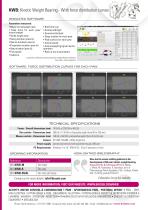
KWB: Kinetic Weight Bearing - With force distribution curves DEDICATED SOFTWARE Parameters measured: • Mean forces/weight ratio • Peak force for each paw/ animal weight • Stride length /paw • Swing duration /paw (s) • Stance duration/ paw (s) • Propulsion duration /paw (s) • Step duration /paw (s) • Paw speed • Cadence • BoS front rear • Overlap left/right • Scored prints/total • Steps number for each paw • Peak surface for each paw • Animal speed • Animal weight (g) (given by the operator) • Ratio of any 2 parameters Screenshot of Bioseb’s Advanced Dynamic Weight Bearing Software: dual...
Open the catalog to page 2All Bioseb catalogs and technical brochures
-
CHP
2 Pages
-
Rotarod
2 Pages
-
OF3D
2 Pages
-
ACTIVWHEEL
2 Pages
-
BIO-GS3
2 Pages
-
BIO-VETALGO
2 Pages
-
SMALGO
2 Pages
-
Deltaphase Isothermal Pad
1 Pages
-
BiosebLab Catalogue 2021
2 Pages
-
Bioseb Catalogue 2021
4 Pages
-
Infrared thermometer
2 Pages


